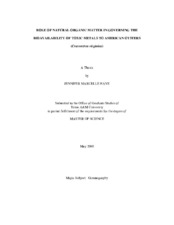| dc.description.abstract | Colloidal macromolecular organic matter (COM), which makes up a large portion
of the bulk dissolved organic matter (DOM) in marine environments, has the capability to
modify the bioavailability of potentially toxic metals to aquatic organisms. In order to
better understand the bioavailability of some of these metals to estuarine bivalves,
American Oysters (Crassostrea virginica) were exposed to different types of natural
colloidal (COM) and model (alginic acid, carrageenan, and latex particles) organic
biopolymers, tagged with gamma-emitting radioactive metal ions (110mAg, 109Cd, 57Co,
51Cr, 59Fe, 203Hg and 65Zn) or 14C (to sugar OH groups). Natural COM was obtained from
Galveston Bay water by 0.5µm filtration, followed by cross-flow ultrafiltration, using a
1kDa ultrafilter, diafiltration and freeze-drying. COM and DOM model compounds were
used in the bioavailability experiments at 2 ppm concentrations. Separate 16-hour
experiments using varying sizes of latex particles assessed the lowest size of colloids that
can be filtered from the water. Results showed that filter-feeding bivalves could
efficiently remove particles as small as 0.04µm (40nm) in diameter, with removal halftimes
of 2.5 to 5.5 hours, equivalent to filtration rates of about 50±15 ml/hour, or about 3
L d-1 g-1, which are typical values for these oysters. Results of the 20-hour bioavailability experiments demonstrated that oysters could effectively filter metals bound to COM, with
the metals bound to alginic acid COM being removed at the highest rates from the water.
However, the metals bound to alginic acid were not found in oyster meat in the highest
amounts: it was the metals associated with the carrageenan COM. The 14C labeled
biopolymer data also showed alginic acid to be removed from the water at the highest
rate and, contrary to the metals, was also present in the meat in the greatest amounts.
Thus, while previous experiments suggested that the quantity (i.e., concentration) of
natural organic matter is important for metal bioavailability, it was shown here that the
“quality”, i.e., the type of natural organic matter, is also a factor for controlling
bioavailability, removal and incorporation rates of metals to oysters. | en |


